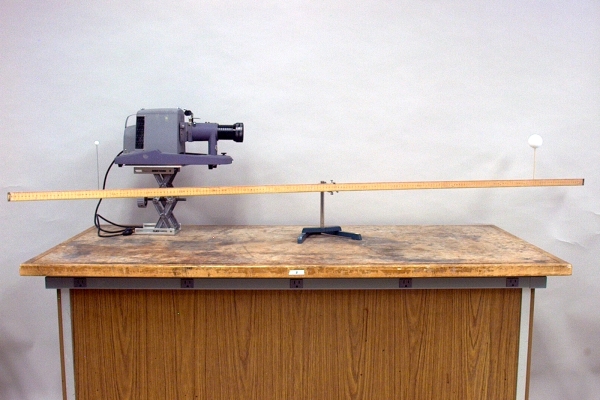
(Thanks to Roger Freedman for suggesting this demonstration.)

(Thanks to Roger Freedman for suggesting this demonstration.)
The two-meter stick holds a 2-inch-diameter ball, for the earth, and a 1/2-inch-diameter ball, for the moon, approximately 59 inches apart. With the projector placed some distance from the apparatus, the 1/2-inch ball casts a shadow on the 2-inch ball, thus illustrating what happens during a solar eclipse. Depending on the arrangement, the shadow may be visible to most of the class. A camera trained on the 2-inch sphere makes it easier to see, and allows you to display it to the whole class. If you reverse the orientation of the apparatus, the 2-inch ball casts its shadow on the half-inch ball, illustrating what happens during a lunar eclipse.
The moon is about one-quarter the size of the earth, and just under 30 earth diameters away from it. (The ratio of their radii is 1:0.2727, 6,371.0 km:1,737.1 km, and they are approximately 378,000 km apart.) So a 2-inch-diameter sphere and a 1/2-inch-diameter sphere, placed 59.3″ are reasonably close to scale. Because the moon orbits the earth, and the earth-moon system in turn orbits the sun, it is possible for the three, at certain times, to line up so that, as shown by this model, either the moon blocks some of the light coming from the sun to the earth, causing a solar eclipse, or the earth blocks the light illuminating the moon, causing a lunar eclipse. If the moon’s orbit around the earth lay in the same plane as the earth’s orbit around the sun – the plane of the ecliptic, then each of these events would happen once per month. At each position where a full moon normally occurs, we would have a lunar eclipse, and at each position where a new moon occurs, we would have a solar eclipse. (The ecliptic is the apparent path the sun takes relative to the stars, as a result of our motion in orbit around it. The plane of this path is the same plane in which the earth’s orbit around the sun lies.) The moon’s orbit, however, is tilted 5° with respect to the ecliptic, so the only times an eclipse can occur are when the moon, earth and sun lie on the line along which the plane of the moon’s orbit intersects the ecliptic. This is called the line of nodes, since it connects the two points where the moon’s orbit crosses the ecliptic, which are called nodes. So put another way, the only times an eclipse can occur are when the line of nodes lies along the line that connects the earth and the sun, or when the line of nodes points toward the sun.
Because of the relative sizes of, and distances between, the sun, moon and earth, the shadow of the moon during a solar eclipse has two regions. The central region, in which the sun is entirely blocked (during a total eclipse), is called the umbra, and is on the order of 250 km in diameter. (According to the Chaisson and McMillan text Astronomy Today, even under the most favorable conditions, it never exceeds 270 km.) The rest of the shadow, over which the sun is only partially blocked, and which is about 7000 km across, is called the penumbra. Though the type of light source and geometry are not ideal, this demonstration actually does a fairly good job of showing these two parts of the shadow, as we can see in the photographs below.
The photograph at left was taken in normal room light, and for the one at right, the lights were dimmed.
In both, you can see a portion of the shadow in the center that is darker than the surrounding shadow.During a total eclipse, anyone within the area where the umbra lies, observes a total eclipse. Anyone outside the umbra, but still within the penumbra, sees a partial eclipse, with those closest to the umbra seeing the greatest coverage, and those toward the outside of the penumbra, the least.
The fact that the sun and the moon occupy almost exactly the same size portion of the sky, about 0.5°, is what makes it possible to observe a total eclipse and simultaneously see the sun’s corona, its outer atmosphere. The moon’s orbit is not quite circular, however, and if an eclipse occurs when the moon is farther from the earth, rather than nearer, it does not quite cover the sun’s disc. In such cases, we observe an annular eclipse. All of the sun is blocked, except for a thin ring along the edge of the disc; there is no region of totality. (At perigee, the moon is about 363,000 km from earth, and at apogee it is about 406,000 km from earth. This difference is significantly greater, proportionally, than that between earth’s perihelion (~147.1 million km) and aphelion (~152.1 million km).)As noted above, you can also set this apparatus up to show a lunar eclipse:
A lunar eclipse, as you might guess from the photograph above, is visible from all points of the night side of the earth.
References:
1) NASA’s Moon Fact Sheet.
2) NASA’s Earth Fact Sheet.
3) Chaisson, Eric and McMillan, Steve, Astronomy Today. (Upper Saddle River, New Jersey: Prentice-Hall, Inc., 1999) pp. 16-20.